
Navigation
Part C: Purple
- Back to Page 1:
Lane Crauford - Page 2: Craufords of Hoxton
- Page 3: Craxford / Cox
- Page 4: Crauford Credits
- Page 5: Letters
The Supplements
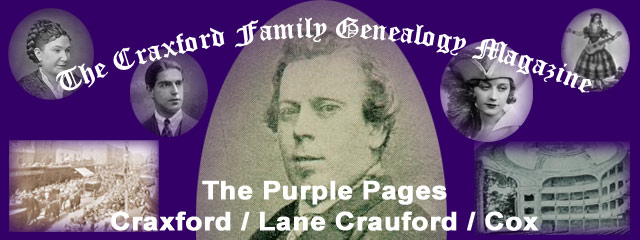
![{$text['mgr_purple1']}](../tng_placepurple.jpg) Britannia 1
Britannia 1
The making of the Britannia Theatre
by Alan D. Craxford and Reg Moore
Introduction
This article is a resume of the founding and history of the Britannia Theatre. Operating for over half a century in an unfashionable suberb of North East London it was the brainchild of one man, Sam Lane, and gave the soubriquet “Queen Of Hoxton” to his wife, Sarah. I have borrowed heavily from the 1933 biography of the couple "Sam & Sallie" (1) written by Alfred L Crauford and have supplemented it with complementary information from other sources. The author admits that the book is a novel and that he took liberties with the narrative to fill in various historical gaps. The intertwining of the branches of their family trees is documented in the companion article ("The Britannia Comes To The Craxfords").
A seed is sown
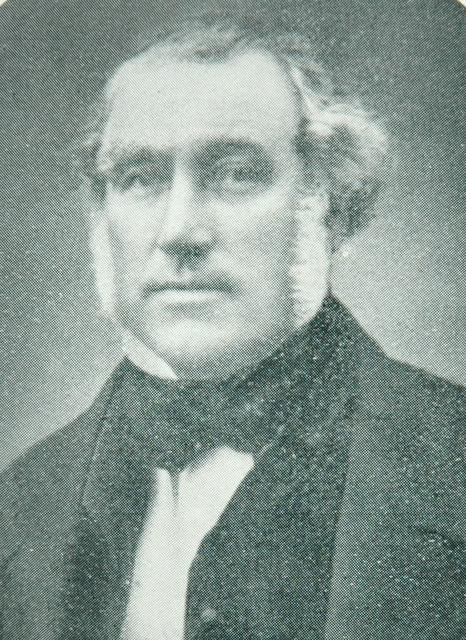
Sam Lane
Samuel Haycraft Lane was born in the tiny fishing village of Lympstone, Devon in 1803. There was nothing in his heritage (a distant ancestor at the time of Elizabeth I was said to have introduced Raleigh to tobacco) or environment (He left school with little formal education) to suggest that he would not serve out his days in those surroundings. Crauford describes Lane’s dramatic rescue from drowning in the River Exe of a honeymooning couple, the Borrows, from London in 1821 which probably triggered his fateful journey.
A naïve, semi-illiterate fisherman, Sam Lane decided that he must leave his home and seek his fortune in London (this adventuresome trek of bread and cheese, robberies and helpful strangers, takes up several chapters of Crauford’s missive). On route he falls in with a group of strolling actors lead by Jack Adams and Sam is able to earn food and a little money by travelling with them and helping out with the plays and performances.
Once in London he is befriended by two individuals who are to become his lifelong companions – a one legged street sweeper, Joseph “’Oppy” Ridley, and a bank clerk, William “Bill” Brian, who had fallen onto hard times. It was Bill who undertook Sam’s education. For a number of years Sam found work as a dock labourer but he also took the opportunity of renewing his friendship with William Borrow who, with his brother, ran a cab business nearby. William by this time had a daughter that he named Sarah (who was also known as Sallie). He was also acquainted with a foreman who worked behind the scenes at the Covent Garden Theatre through whom he found further employment for Sam.
In the mean time (around 1830) Sam came across Jack Adams and his troupe again, still travelling and performing at one of the big London fairs. He said that he was looking for a permanent base and with his local knowledge Sam was able to negotiate a lease for Adams to use the hall at the Union Tavern in Shoreditch. The hall was able to cater for 500 people seated and a similar number standing. The company presented a programme of drama, song and dance and acrobatics. The operation was a tremendous success.
Ups and downs
Sam was introduced to Jack’s daughter Mary and they were married in 1835. Bill became the theatre manager and Joe was made landlord of the tavern.
In 1839 the company fell foul of the law by giving a performance of 'Othello'. Content of shows in London was under the control of the “Law of Theatrical Amusements” which restricted the performance of dramatic works, including Shakespeare, to certain designated theatres. Sam was given a heavy fine and his licence was taken away. The subsequent publicity was sufficient to see changes in legislation enacted in Parliament but for many months they were out of work.
By 1840 Sam and his advisers had come up with the idea that they could circumvent the legal restraints by providing their performances free and charging for programmes, food and drink. A search for new premises brought them to the Britannia Tavern in Hoxton High Street which also had a large attached hall. This was said to be the site of the Pimlico, an Elizabethan tavern frequented by Shakespeare whose nearby theatre was called “The Curtain”. Adjacent to the tavern was Pimlico Walk and in local gardens. The new venture “The Royal Britannia Saloon and Britannia Tavern” opened on Easter Monday 1841 to a tumultuous reception from the neighbourhood and sell-out performances.
Within a year it looked as if Sam’s world would be crowned when Mary became pregnant. This was not to be as some months later Mary slipped and fell at a rehearsal. She went into early labour following which both she and the baby died.
What was happening to the Borrows
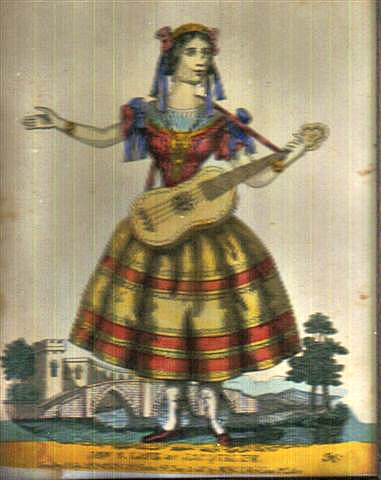
Sara Lane as Jacquelline (about 1850)
In the late 1830s William sustained a fracture to his leg when he fell getting down from a cab. When this did not heal he underwent an amputation of the leg in 1841. There were family problems with his brother and the cab business suffered badly. William had five children by this time; the youngest – Charlotte – was born in 1838. Much to his concern, Sallie was making a name for herself as an actress and dancer under the stage name “Miss Sarah Wilton”.
Crauford documents some jealousies between Mary Adams and the much younger Sallie and because of this Sam’s visits to the Borrow’s house had become infrequent. However after this accident he offered William a managerial position at the theatre. He also became aware of “Miss Wilton” and once he realised that it was Sarah he persuaded her to join the company at the Britannia. A relationship blossomed between them and they were married in Devon in 1843. Sarah became the theatre’s leading lady, starring as principal boy in their renowned pantomimes and having plays written specially for her. Her sister Charlotte also started to appear in juvenile roles.
The Britannia was particularly noteworthy that once an individual had joined the company he tended to stay for a long time and become a member of the family. The search for new talent continued as the years passed by. In the early 1850s a William Crauford joined the cast. He had been working on a part time basis for a rival theatre, the Bower Saloon in Lambeth. Pretty soon he had fallen in love with the young Charlotte Barrow. They eloped when she was aged 16, spending their honeymoon in Margate before facing the wrath of Sam and Sallie.
The theatre continued to play to packed houses. In 1858 Sam was able to buy up the leases for a number of the surrounding properties. During the summer of that year the old theatre was demolished and a new theatre with a much larger capacity was built. It opened in November 1858. Its audience comprised of local townsfolk and dignitaries alike.
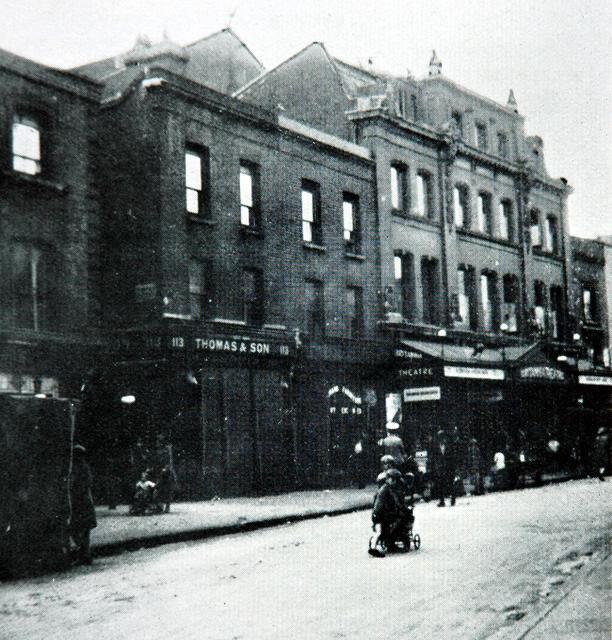

The Britannia Theatre, Hoxton: Exterior and interior views
Crauford notes that “in all its pristine youth, in all its gilded decoration and fresh paint and varnish, it was indeed a palace in this sordid East End street, an object of amazement and wonderment. It did indeed look out of place in this comparatively narrow market street among the costermongers and their barrows. The exterior was of white stone and the windows were numerous and large. There were two circles: the first, called boxes would seat 300 people; the pit was spacious and held 1200; the gallery held as many. The stalls would accommodate 400. The whole of this gigantic house would give seats to 3200 people and so considerable were the standing room spaces that the record number that the theatre has held is 4790.”
Please contact us
 If you have any questions or comments about the information on this site in general, or you have further information regarding this article, please Get in touch by leaving a message in our Guestbook. If you don't want the message to be added to the Guestbook, just say that in your text. We look forward to hearing from you.
If you have any questions or comments about the information on this site in general, or you have further information regarding this article, please Get in touch by leaving a message in our Guestbook. If you don't want the message to be added to the Guestbook, just say that in your text. We look forward to hearing from you.
Added: September 4th 2005
Updated: March 26th 2012
Return to Top of Page
Translate this page:
Further developments
When London theatre prices “were up to half a guinea” the gallery cost 3d., a pit seat 6d.,(six old pennies: two and a half pence) boxes and stalls were 1s. (one shilling: five pence) Charles Dickens was a visitor and his description of the theatre (2) is particularly telling:

Letter to The Times
“Magnificently lighted by a firmament of sparkling chandeliers, the building was ventilated to perfection. The air of this theatre was fresh, cool and wholesome. It has been constructed from the ground to the roof, with a careful reference to sight and sound in every corner, the result is that its form is beautiful and that the appearance of the audience as seen from the proscenium with every face in it commanding the stage and the whole is so admirably raked and turned to that centre, and is highly remarkable in its union of vastness and compactness. The stage itself and all its appurtenances of machinery, cellarage, height and breadth are on a scale more like the Scala at Milan or the Grand Opera at Paris than any notion a stranger would be likely to form of the Britannia Theatre at Hoxton, a mile north of St Luke’s Hospital in the Old Street Road. “The Forty Thieves” might be played here and every thief ride his real horse; and the disguised captain bring in his oil jars on a train of real camels and nobody be put out of the way. This really extraordinary place is an achievement of one man’s enterprise and was erected on the ruins of an inconvenient old building in less than five months at a round cost of five and twenty thousand pounds.”
Dickens was also concerned about the use of proprietary materials and plagiarism of authors’ works but he does appear to have developed a good working relationship with the management of the Britannia as a letter he wrote the The Times (3) showed.
The end of an era
The theatre continued to be an unfettered success. Particularly popular were shocker dramas such as 'Sweeney Todd, the Barber Fiend of Fleet Street' or 'Maria Martin: The Murder in the Red Barn.' as well as its Christmas pantomimes - the season of which would run right through to Easter. It was equally necessary for any actor, artist or singer of note or merit to appear at "The Brit". The list of these luminaries is long and includes George Lupino, Vesta Tilley, Arthur Lloyd, Joseph Reynolds and George Bigwood. Renowned Shakespearian actor of the time, James Anderson, was engaged at a salary of £180 a week in 1851.
Playbill Images are copyright and have been supplied by Special Collections, Templeman Library, University of Kent.
The Special Collections Web Site.
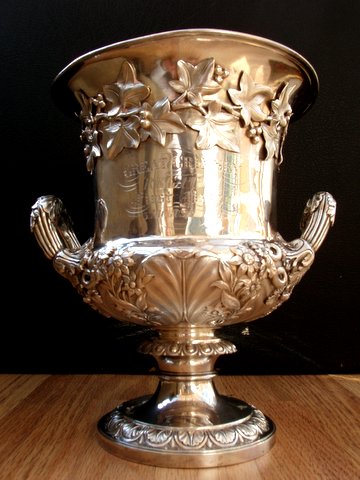
Trophy from Great Grimsby Regatta 1854
As the years passed, Sam Lane did acquire some of the trappings of fame and wealth. He bought properties in Exmouth and developed a passion for yachting (winning many trophies with his vessel 'The Phantom'). Sam suffered a stroke in July 1871 which was said to rob him of the power of speech and much of his business and theatrical capabilities.
He died towards the end of that year. His estate, including the theatre, were bequeathed to Sallie having entreated her to “Keep the place! Don’t part with it for any money in the world”.
Sarah Lane was not a business woman and left the management of the company in the hands of her father, William Borrow. Within a year he too was dead. Over the succeeding years, a succession of managers came and went, trying new formulas and ventures but the general trend of was slowly downwards and ultimately the Britannia was losing money. In 1882 she took the bold step of appointing her sister Charlotte’s second son, Alfred, to be general manager at the age of 22 years.

Sarah Lane
Sallie still enjoyed her roles on stage and taking her part in the community. She was charitably generous and was an easily recognised personality that the locals dubbed 'The Queen of Hoxton'. "She was so well loved of the surrounding districts that she could go alone unmolested where policemen had to go in couples"(4). Her last appearance on stage was in December 1898. She died in August 1899. She was given a public funeral and crowds lined the route of the procession from the theatre to the cemetery at Kensall Green.
Despite his two marriages Samuel Lane left no heirs. Sarah left the residue of the estate including The Britannia Theatre to her nephews, Alfred and William. Unfortunately within a year further problems arose for the new owners after a fire seriously damaged a theatre and London County Council served a list of over one hundred statutory requirements to bring the building up to standard. With the high costs that these entailed and the increasing threat from alternative forms of entertainment, the lease was sold on.
At the outset of the first World War Alfred was now the sole owner. During this time the theatre began the showing of films. After the end of hostilities the lease was transferred to the Gaumont organisation.
The Britannia continued as a cinema until the outbreak of World War II. It was destroyed by bombing in the blitz.
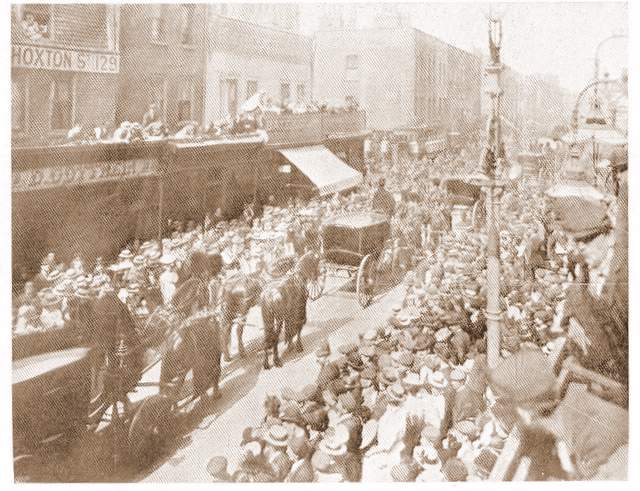
The funeral procession of Sarah Lane
Appendix
Alfred L Crauford wrote the following in the introduction to his book:
“READER! May I ask you to read this introduction for your better understanding and interest in this my story. I am aware that introductions are too often skipped. But I claim this to be, in a way, an unusual book. In novels of the present day it is often the custom to announce as a prelude that ‘the characters in this book are entirely fictitious and are not drawn from any person in real life.’ My foreword is entirely the contrary: and in this respect I claim that whatever its shortcomings – and I leave this to my reader’s opinion – the characters in this book are drawn from actual life.’ They have drawn the breath of life and in a broad sense have acted as I relate.
It must not be understood that in the development of this story I have confined myself to actual facts. Where the truth is known of the careers of my characters I have strictly adhered to it, as handed down to me either by personal knowledge of from numerous letters and documents; but there are periods when what actually happened to them is obscured in the mists of the past. In these cases I have allowed myself as much liberty as if the facts were entirely of my own invention but in all cases adhering to probabilities. My purpose is to make fact pass for fiction!!
I shall relate the story or adventures of real people; they will not do romantic deeds; they will not slay dragons or rescue maidens in distress; they rise from the lowly of the land and they act as human beings. That this is no wild assertion is obvious because they once lived the lives I have described; they were real flesh and blood. The proof is in the documents handed down to their posterity and some of the facts are matters of theatrical history.”
References
1. “Sam and Sallie: A novel of the theatre”: Crauford Alfred L. Cranley and Day, London (1933)
2. “The Uncommercial Traveller”: Chapter IV: Two Views Of A Cheap Theatre”: Dickens Charles (1865) : text available for download from: www.readbooksonline.net/title/133
3. Letters to the Editor of The Times; Dickens Charles. The Times Issue 23828 7 Col D. January 12th 1861
4. “Britannia Theatre, Hoxton.” (2004) www.arthurlloyd.co.uk/Britannia.htm
Internet Beacon Diamond Site - 2010
© The Craxford Family Genealogy Magazine and individual copyright holders.Edited and maintained by Alan D. Craxford 2005 - 2025. All rights reserved. Contents may not be reproduced without permission.
You are not authorized to add this page or any images from this page to Ancestry.com (or its subsidiaries) or other fee-paying sites without our express permission and then, if given, only by including our copyright and a URL link to the web site.
















